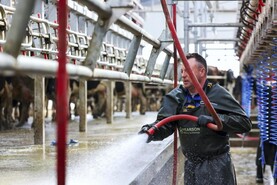I had an email from a young farmer recently regarding setting up a new dairy. They were currently renting 43 acres next to the home block, which was just under 30 acres in size, with the hopeful plan being able to build on the owned land when it is passed on to them and utilise the two units to milk a herd of approximately 50 cows.
Firstly, the block of owned land is still being farmed by the young farmer’s father.
A partnership or transfer of the land would have to take place to justify the infrastructure spend that would ensue from creating a new dairy enterprise. Secondly, the young farmer would have to talk to their landlord regarding the development of their land, with roadways and other grazing infrastructure required to milk cows.
If the land was on a short term lease, development would not be viable, and I recommended that the young farmer secure a 15-year lease if not currently in one if they wished to go down the dairy route.
One of the glaring things about the email was the lack of winter accommodation. The young farmer had no wintering facilities.
Recent Teagasc analysis shows a cost per cow of approximately €3,000 for cubicle spacing and slurry storage. This would put a 50-cow cubicle shed at roughly €150,000.
As the young farmer was not in a farm partnership, if they were to go down the line of TAMS they would be limited to €90,000 of a reference cost which would max out at €54,000 which would leave them with a net cost of €96,000.
At this, their TAMS aid would be maxed out on the cubicle accommodation. For cost reasons, I would then choose the route of a good second-hand parlour 10-12 units in size.
These can be sourced for approximately €20,000-30,000. Going secondhand again, we would need a 4,500-litre tank (50 cows x 30 litres/day x three days) to service the parlour, putting this at a cost of €8,000.
Both require fitting, and I would expect the labour cost to be circa €20,000.
After this, they would still need a shed to hold the milking parlour and dairy, as well as soiled water storage, calving and calf accommodation.
A slatted collection yard which would act as a soiled water storage facility would cost approximately €25,000, while an 80ft x 40ft shed to house all the above would cost in the region of €80,000 when all work was completed.
Looking at the above bill, we are now sitting at €254,000 + VAT of a net cost, with €56,000 also having to be financed while awaiting TAMS.
Stock costs will also have to be factored in, and these could range from €50,000 for maiden heifers up to €100,000 for high end in-calf heifers or young cows.
If the young farmer was to take the above figure of circa €300,000, what sort of a repayment are they looking at making?
A 10-year loan for €300,000 at 4.5% interest will have a monthly repayment of approximately €3,109, with a total interest paid of approximately €73,098 across it’s lifetime.
This is a debt:cow ratio of €5,000/cow which is far from attractive.
We also haven’t factored in any grazing infrastructure costs in to the equation.
The likelihood is that the young farmer in question would have to continue working off-farm either on a full- or part-time basis to support this investment, as €37,308 and a wage would likely be too much of a pull on their finances.
Come the end of the 10 years, the farm would have the loan paid off, but would only have five years left on the land lease that is the majority of the milking platform.
As well as this, the young farmer will have been working for 10 years milking cows morning and evening before and after work.
Whether the young farmer in question would even be given a loan from the bank, with possibly just 28 acres as security, is also questionable.






 This is a subscriber-only article
This is a subscriber-only article










SHARING OPTIONS: